Supermarine Spitfire
Mk.IXc & Mk.XVIe
High & Low-Back Versions
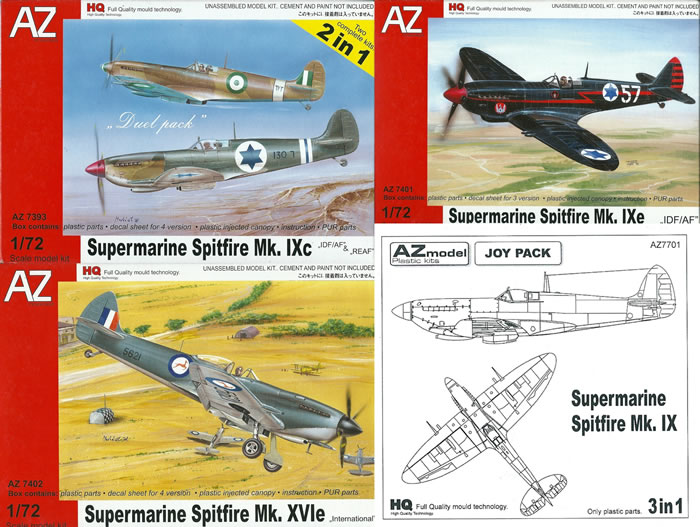
A.Z. Model, 1/72 scale
S u m m a r y : |
Catalogue Number: |
AZ7393 Spitfire Mk.IXc IDF/AF & REAF (2 kits)
AZ7401 Spitfire Mk.IXe IDF/AF
AZ7402 Spitfire Mk.XVIe International (low-back)
AZ7701 Spitfire Mk.IX Joy Pack (3 kits, no decals) |
Scale: |
1/72 |
Contents & Media |
Box # |
Number of Kits per Box |
Number of Parts or Options per Kit |
Tan Styrene |
Clear Styrene |
Resin |
Decal Subjects |
AZ7393
AZ7401
AZ7402
AZ7701 |
2
1
1
3 |
63
58
57
63 |
1
1
2
1 |
1
1
2
1 |
4
3
4
0 |
Price: |
Box # |
On-Line Stockists |
AZ Models |
Hannants |
Modelimex |
AZ7393
AZ7401
AZ7402
AZ7701 |
€19.19
€14.00
€14.00
€14.00 |
£23.50
£17.30
£17.30
Not Listed |
€16.46
€22.08
€22.08
Not Listed |
Review Type: |
First Look. |
Advantages: |
Very crisp moulding, fine panel lines, good detail levels for the scale, good quality decals and very straightforward to build. |
Disadvantages: |
No shrouded .50-cal muzzles for the E-wing options are supplied (but easy to remedy). The Mk.XVIe low-back’s two upper wing wheel bulges are a different shape and size to each other. The canopy clarity is okay, but below the high standard set by the rest of the components. |
Conclusions: |
I think that these are the best injected kits of the Spitfire Mk.IX & XVI available. They are beautifully moulded, have good detail levels, nice decals, and come boxed in a variety packages; all of which offer very good value. I hope that AZ Models issues all of its future releases using their new “HQ” mould technology.
The fuselage may be both fraction short and a tad shallow in the rear fuselage when compared to my personal benchmark kits by CMR. The differences are within 1-mm, or a scale 3-inches; an amount that I think is an insignificant amount for most modellers. This is a small point when weighed against the many good features of these kits. The canopies are acceptable and may improve with a dip in future, but they are below the standard of the other kit parts.
These kits will, I am sure, be very well received by Spitfire buffs. I have every reason to expect that they will be a pleasure to build into fine looking models, and so recommend them highly. |
Reviewed by
Mark Davies

HyperScale is proudly sponsored by
Squadron.com
The Spitfire needs no introduction, so I shall not provide one. I will however just reiterate the fact that the Mk.IX and Mk.XVI were externally identical. The former used a Merlin 66 engine built in the UK by Rolls Royce, and the latter an equivalent version by Packard licence-built in the USA. The two engines gave the same performance but lacked interchangeable parts; this was because the Packard had been Americanised with different tolerances, bolt threads and so on. There were low-back versions of both these marks. They had the same airframe as the conventional Spitfire, but with a cut-down rear fuselage and bubble canopy. Low-backs began to enter service early in 1945, and most were Mk.XVIe’s.
Previous 1/72-Scale Spitfire Mk.IX & Mk.XVI Kits
I will ignore the very few TR.9 and other two-seat Mk.IX kits and focus on single-seaters. There has been quite been a lot of 1/72 Spitfire Mk.IX kits over the years (although only a few were boxed as Mk.XVI’s). Only Heller, CMR and Sword offered low-backs. All are injected kits unless otherwise noted.
The first was by Airfix in 1960 or possibly Lindberg (1/75-scale), followed in no particular order by Frog (re-boxed by Intech), Cruver, Lotnia, LB Models (resin), Matchbox, KP (re-boxed by Mastercraft Models), Esoteric (resin), Ventura, Heller (low-back), Hasegawa, Italeri, CMR (resin with various conventional and low-back boxings). I have also read of the existence of a Mk.IX by Monogram, but have no other information about it. More recently, there have been new releases by Airfix and Sword. I thought that the Airfix kit was a disappointment with too many faults. Sword offered both Mk.IXe and Mk.XVIe kits, including a low-back boxing, which I reviewed here on HyperScale.
I feel that CMR’s Mk.IX and Mk.XVI kits are the best overall because of their accuracy, options and attention to detail. Although Sword’s rear fuselage is slightly shallower than CMR’s it still matches the resin brand for general accuracy; and so I felt it was leading the injected Mk.IX & XVI kit stakes in my opinion - until now at least.
The Contents
All of the AZ Model kits reviewed here are essentially the same, sharing common sprues. The low-back boxing has an additional sprue for the low-back fuselage halves, some wheel bulges, bomb racks, and of course a different canopy.
The kits come in typically Czech end-opening boxes with attractive enough artwork on the front. The instructions have a parts map and use easy to follow assembly diagrams. These are adequate, and have colour call-outs cross-referenced to the Humbrol paint range. The last page of the instructions has a stencil placement guide. There is also a brief history of the aircraft, and all text is in English. The painting and decal guide is in colour on the reverse side of the box using profiles and small upper and lower plan views. A resealable cellophane bag encloses the parts and decals, with the clear and resin parts each in small bags of their own.
The various boxings have different numbers of kits within; by doing so they offer a number of different value propositions. AZ73093 is a sort of dogfight double with two Mk.IXc kits and markings for Israeli and Egyptian machines. AZ7401 has one kit and markings for a selection of Israeli Mk.XVIe’s. AZ7402, the Mk.XVIe low-back boxing, has one kit and markings for four nationalities. The most unusual boxing is AZ7701, this is described as a “Joy Pack” and contains three high-back Mk.IX’s without decals and one set of instructions. This sells for the same price as the single kit boxings with decals, and represents great value if you have after-market or spare decals to apply. There are at least three other boxings of the Mk.IX kit, which I did not receive for review, and are described on stockist’s web-sites as follows:
-
AZ7391 Supermarine Spitfire Mk.IXc 'ACES' (4 x RAF),
-
AZ7392 Supermarine Spitfire Mk.IXc 'Early Tails' (2 x RAF & 2 x USAAF), and
-
AZ7390 Supermarine Spitfire Mk.IXc 'MTO' (4 x RAF).
New Production Standard
A Czech friend of mine mentioned to me that AZ Model has changed the third party contractor it uses to mould its kits, and I can only commend their decision. These have the best quality moulding I can recall have seeing in limited run kits. Upon opening the box and seeing the sprues you could be forgiven for thinking you were looking at a mainstream long-run kit; in fact, if locating lugs were present you probably would be. They are a huge improvement on previous releases by AZ Model. To distinguish them from other AZ Model kits the boxes are marked “HQ”, “Full Quality Mould Technology”, and “High Quality Technology”.
The Kits
Moulded very crisply, all parts have fine surface detail, and the parts break down is conventional for the type. The sprue gates are narrow, and there is no flash to speak of at all. The only resin parts are the floor frames for the Mk.XIc and late model round exhausts for the Mk.XVIe low-back. The Mk.XVIe has the floor frame in plastic rather than resin, and this is all that is needed as no fine detail is found here. I suspect that the floor frame is supplied in resin with the Mk.IXc and Mk.XVIe high-back kits because it was missed out when the mould was made, it being cheaper to supply a resin part than re-tool the mould.
Cockpit detail combines a floor frame with integral rudder pedals, instrument panel, control column, seat, armour, rear frame and headrest, integral sidewall detail, and oxygen bottles. There is a voltage regulator to go behind the headrest, but I have a feeling this may only be applicable to converted Mk.V’s and rather than to later Mk.IX’s & XVI’s. A gun-sight finishes the detail in the cockpit area; this is in tan rather clear plastic, so many will wish to replace the reflector glass. No seatbelts are included, which is a pity as some AZ Model kits have seats with a harness moulded in place. Nonetheless, the very well detailed cockpit will be fine as is for a closed canopy model with seatbelts added. There is a choice of early or late style carburettor intakes, horizontal stabilisers and rudders.
The wings as supplied are C-Wing type and have the barrel holes and spent case ejection slots for four .303 guns of the Universal Wing, along with two 20-mm cannon and the rounded caps used with the two empty cannon bays. There is a choice of wide or slim cannon breech bulges. The wings come moulded as low-level clipped versions, although regular wing tips are included on the sprue. It is necessary to remove the clipped tips to fit the regular tips. I would have preferred both tip types to be separate, as is the case with the Revell Mk.V kit for example.
The instructions correctly direct the builder to fill the .303 gun muzzle holes and ejection chutes in the wings for the Mk.IXe and XVIe. Unfortunately, there are no .50-cal shrouded muzzles for the E-wing options; the instructions direct that the blanking caps be fitted in the inboard gun location instead. It should not be too hard to flatten the ends and drill these out to represent the shrouded .50-cal muzzles however. The Mk.XVIe low-back has two bomb racks for the wings, whereas the high-back kits do not.
The wheel wells have appropriate walls and an acceptable level of detail for the scale. There is a choice of large or small diameter wheels with three or four- spoke rims respectively, and the undercarriage as a whole looks fine.
The Mk.XVIe instructions give the choice of having “turtle back” wing bulges and two very slender streamlined reinforcing ribs that fit just outboard of these. Unfortunately, the turtleback bulges are different sizes and shapes. It is possible that this may be a short-shot issue with my review sample, but I am inclined to think that it is a tooling error. The fitment of these bulges varies across both Mk.IX’s and XVI’s, so check references if possible before fitting them. However, they only usually seem to be fitted to late-build Mk.IXe and XVIe airframes.
It may be that the late-war Spitfires were fitted with “straight” axles (they look to be at right angles to the leg but were actually 4° off perpendicular) as these were best for operating from sealed runways; unlike the usual angled axes that were optimised for grass strips. It could be that the wheels when fitted to “straight” axles just fouled the internal wheel-well structure on the standard wing because the angle they sat at in the well had changed when the leg was stowed. The bulge presumably provided the required clearance for the re-angled wheel. But this is speculation, and unfortunately it does not clarify whether or not only one wheel type should be used. If anyone can shed light on this issue please contact me about it.
The combined radiators and intercoolers sit within with a recessed channel in the lower wing and look authentic. The propeller with its separate spinner and looks fine as well. The fishtail exhausts are nicely moulded, whilst the Mk.XVIe low-back has additional round exhausts as resin parts (these being generally fitted to late-build Mk.XVI’s and Mk.IX’s).
The canopies for both the regular and low-back kits are okay, but only the low-back offers an open option. In fact, and perhaps surprisingly, the clear parts are not quite as good as the rest of the kit, having just a tiny hint of cloudiness. I received AZ Model P-40E to review at the same time as these Spitfires; it is an “old-style” AZ moulding yet it has a beautiful crystal-clear canopy. Go figure!
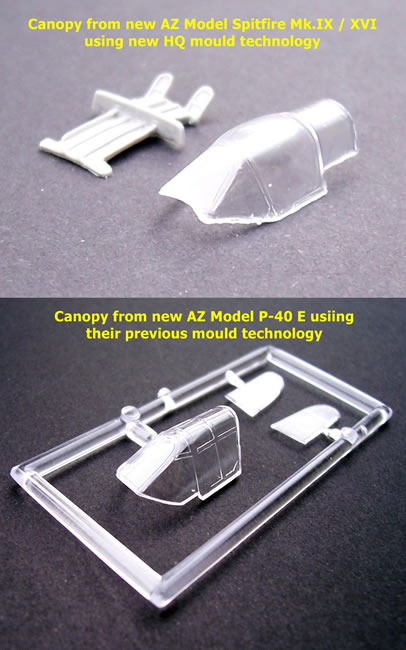
AZ Model has not included 30 and 90-Gallon slipper tanks, or any other underwing stores. Perhaps this is more of a missed opportunity than a true failing.
Overall, I should think that these kits should be very simple and enjoyable builds.
Accuracy
Rather than rely on plans which can be of questionable accuracy, I elected to compare shapes to what I consider to be the best 1/72 Spitfire Mk.IX & XVI kits. These are CMR’s and Sword’s high and low-back kits. After matching the main airframe parts, I could determine no significant differences between all three brands. However, AZ Model is about 1-mm shorter between the area of the cockpit and the tail fin than the other two. About 0.7-mm of this appears to be in the rear fuselage and 0.3-mm in the nose. The AZ Model and Sword kits are both almost 1mm shallower in rear fuselage depth when compared to CMR. Having looked at photos I am inclined to favour CMR’s deeper section. Despite this, I feel that the AZ Model kits are still very good in general terms of shape and accuracy – I leave it to the true Spitfire experts to give us a more definitive assessment.
Colours and Markings
As mentioned already, the “Joy Pack” does not include decals. The other three boxings do, and these all appear to be very nicely produced. The stencil decals are the same as those provided with AZ Models Spitfire Mk.I & II kits, although I doubt that this matters much.
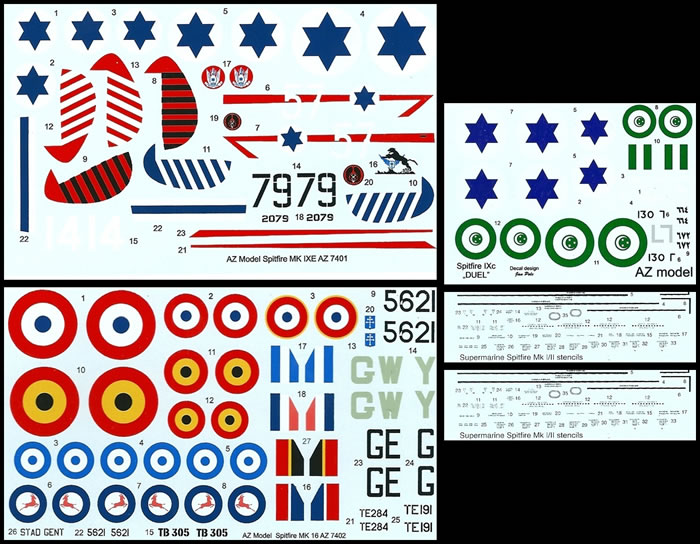
As it happens there were two sets supplied with the AZ7393 twin Mk.IXc pack, but none with either of the single pack Mk.XVIe boxings.
AZ model provide quite a number of varied colour schemes across the boxings reviewed here, these being:
AZ7393 Spitfire Mk.IXc IDF/AF & REAF:
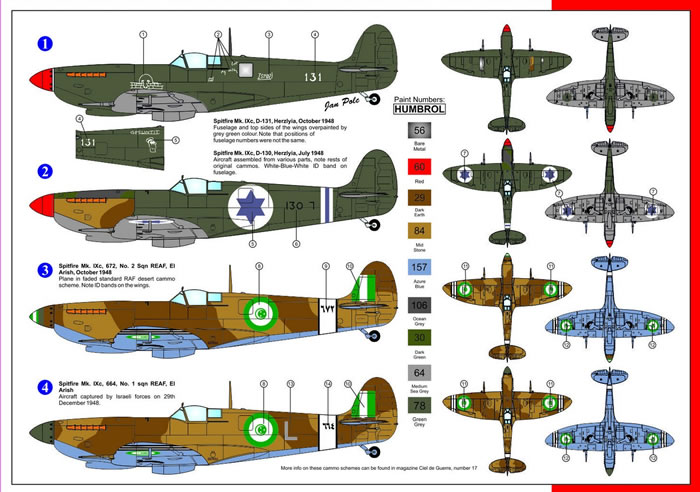
-
D-131, Israeli Defence Force, Herzlyia, October 1948,
-
D-130, Israeli Defence Force, Herzlyia, July 1948,
-
672, No 2 Sqn Royal Egyptian Air Force, El Arish, October 1948, and
-
664, No 1 Sqn Royal Egyptian Air Force, El Arish, December 1948
AZ7401 Spitfire Mk.IXe IDF/AF:
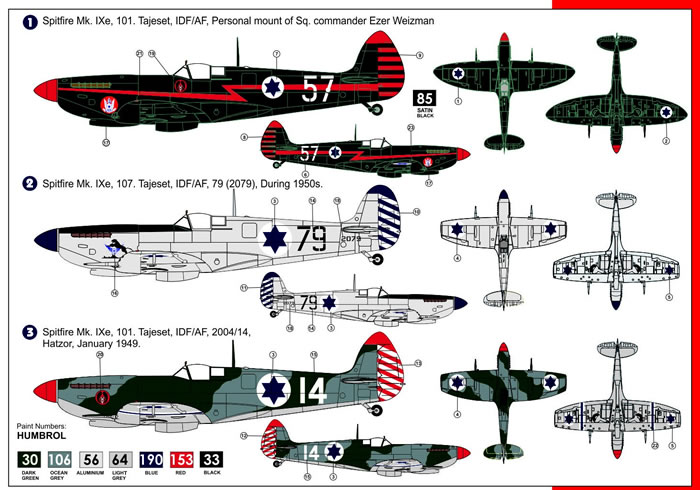
-
101, Tajeset IDF/AF, personal aircraft of Squadron commander Ezer Weizman,
-
107, Tajeset IDF/AF, 79 (2079), during the 1950’s, and
-
101, Tajeset IDF/AF, 2004/14 Hatzor, January 1949.
AZ7402 Spitfire Mk.XVIe International (low-back):
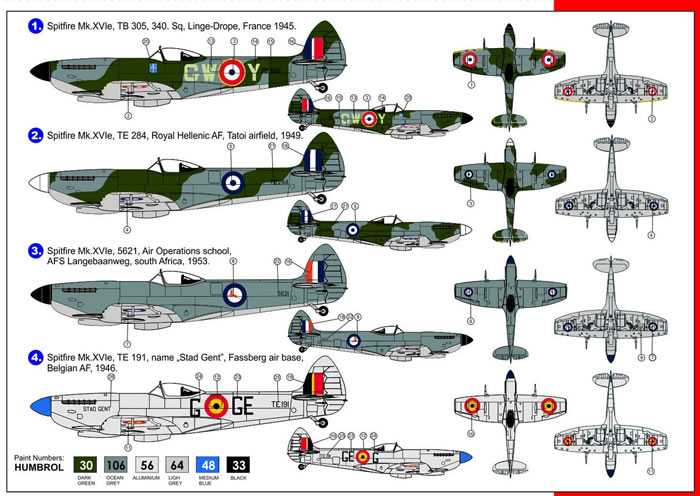
-
TB 305, CW-Y, 340 Sqn, French Air Force, Linge-Drope, France 1945,
-
TE 284, Royal Hellenic Air Force, Tatoi Airfield, 1949
-
5621, Air Operations School, SAAF, AFSLangebaanweg, South Africa, 1953, and
-
TE 19. “Stad Gent”, Belgian Air Force, Fassberg Air Base, Belgium, 1946.
I think that these are the best injected kits of the Spitfire Mk.IX & XVI available. They are beautifully moulded, have good detail levels, nice decals, and come boxed in a variety packages; all of which offer very good value. I hope that AZ Models issues all of its future releases using their new “HQ” mould technology.
The fuselage may be both fraction short and a tad shallow in the rear fuselage when compared to my personal benchmark kits by CMR. The differences are within 1-mm, or a scale 3-inches; an amount that I think is an insignificant amount for most modellers. This is a small point when weighed against the many good features of these kits. The canopies are acceptable and may improve with a dip in future, but they are below the standard of the other kit parts.
These kits will, I am sure, be very well received by Spitfire buffs. I have every reason to expect that they will be a pleasure to build into fine looking models, and so recommend them highly.
Thanks to AZ Model for these review samples.
Review Text & Images Copyright © 2012 by Mark Davies
Page Created 5 November, 2012
Last updated
5 November, 2012
Back to HyperScale Main Page

|
